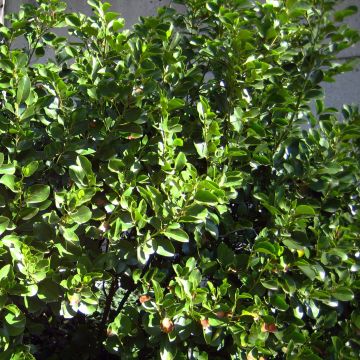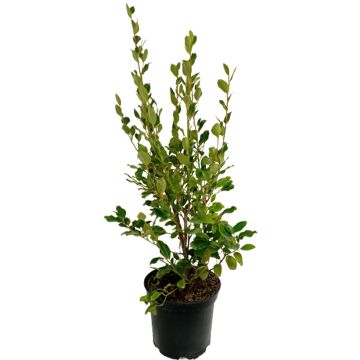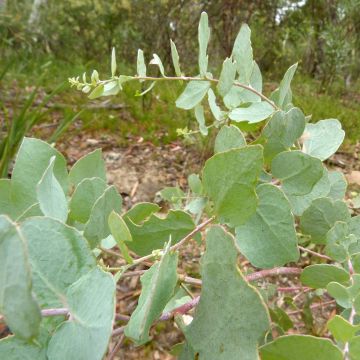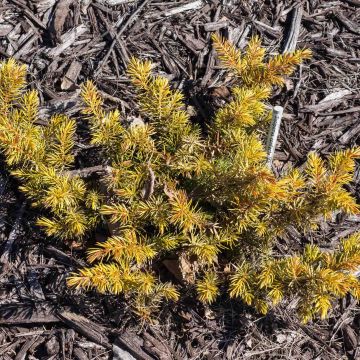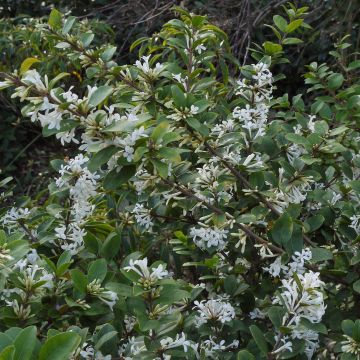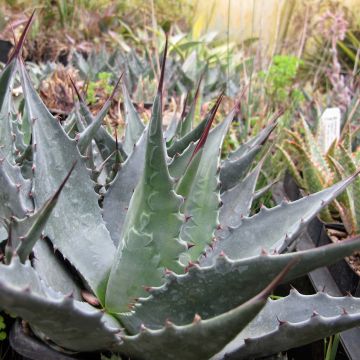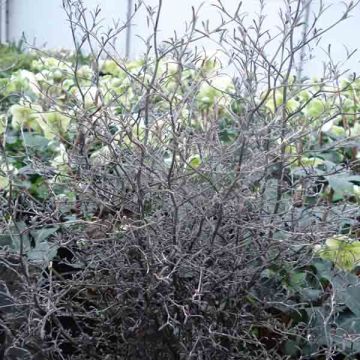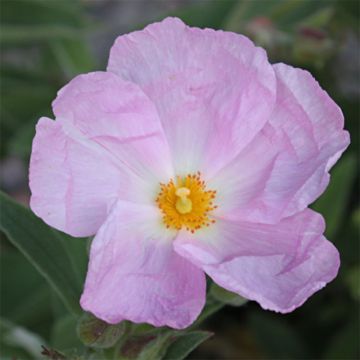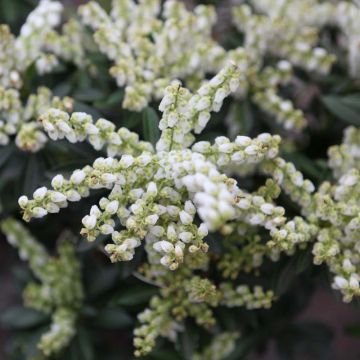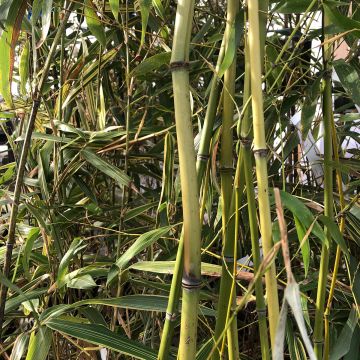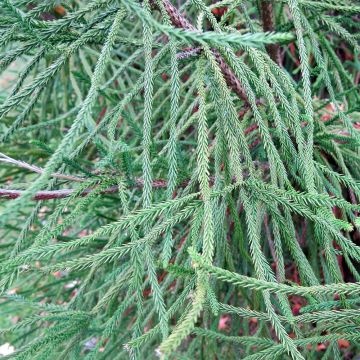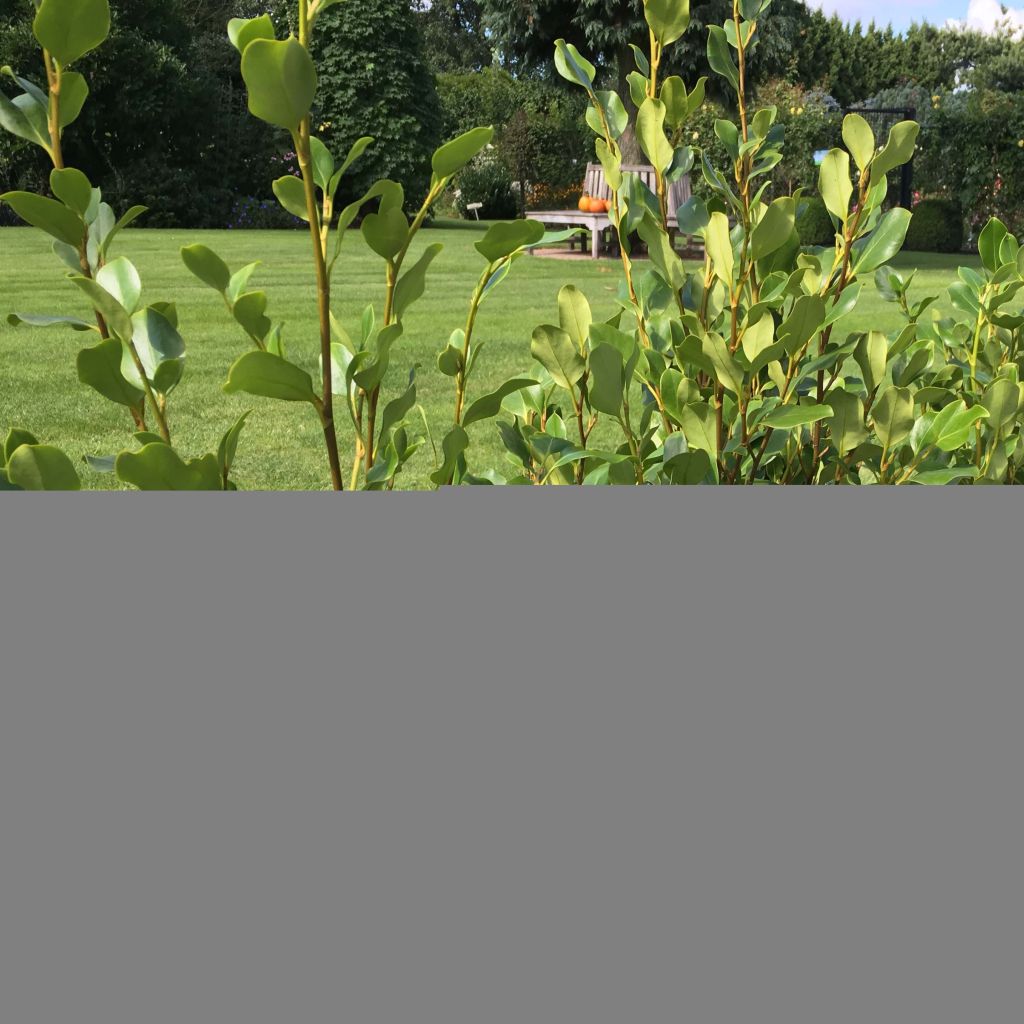

Griselinia littoralis Redge
Griselinia littoralis Redge
Griselinia littoralis Redge
New Zealand Broadleaf, Kapuka, New Zealand Laurel, New Zealand Privet
This plant carries a 24 months recovery warranty
More information
We guarantee the quality of our plants for a full growing cycle, and will replace at our expense any plant that fails to recover under normal climatic and planting conditions.
From €5.90 for pickup delivery and €6.90 for home delivery
Express home delivery from €8.90.
Does this plant fit my garden?
Set up your Plantfit profile →
Description
Griselinia littoralis 'Redge', also known as New Zealand broadleaf, is an evergreen bush ideal for coastal gardens. This recent cultivar is more branched and more disease-resistant and stands out for its average growth of about 30 cm (11.8 in) per year. Its shimmering apple-green foliage contrasts with its very dark branches. With its dense habit and great resistance to summer drought and sea spray, it will be highly appreciated in coastal gardens for creating windbreak hedges. Its discreet but highly fragrant spring flowering is followed by the formation of ripe, black berries on the female plants. Although hardy down to -10°C (14 °F), this bush will appreciate a position sheltered from dry and cold winds, and is best grown in a pot that can be stored away during winter in colder regions
Griselinia littoralis is a bush from the family Cornaceae, just like dogwoods. It is endemic to New Zealand, where it grows in forests along the coastline up to 900m (2952 ft 10 in) altitude. In its natural environment, it can grow into a true tree with multiple trunks, reaching a height of 12m (39 ft 5 in). The 'Redge' cultivar will remain much smaller, only 1.80m (5 ft 11 in) in height and 1.20m (3 ft 11 in) in width. Its habit is upright, very bushy and dense, almost as wide as it is tall. Its growth rate is moderate in slightly chalky and deep soil, about 30cm (11.8 in) per year. In very chalky soil, its growth will be significantly reduced. Its flexible trunk and branches are covered with a smooth bark that turns black and cracks over time. The foliage, more or less evergreen depending on the severity of winter, consists of upright, ovate, incurved leaves, ranging from 4 to 12cm (1.6 to 4.7 in) in length. The texture of young leaves is fine and flexible, then it becomes thick, almost succulent, leathery and very glossy when mature. Their colour is a bright acid apple-green with a very shiny finish. The May-June flowering is more abundant in full sun, but not very visible: it takes the form of small paniculate axillary clusters composed of about a hundred small petal-less greenish-yellow flowers. Although often unnoticed by our eyes, it attracts a large number of pollinating insects that gather a bountiful harvest of pollen. As this bush is dioecious, only the female plants will bear fruit, provided that a male plant is planted nearby. These clusters of fruits are composed of small ovoid, acidic green berries, which turn black when ripe and contain only one seed.
Well suited to coastal areas, Griselinia littoralis 'Redge' can be used to create hedges at the garden boundaries to protect from wind and prying eyes. It adapts well to container cultivation, placed on the terrace or balcony. This cultivation method allows gardeners in cold regions to protect it from severe cold in an unheated greenhouse or conservatory during winter. Its height will be somewhat reduced in pots, but the plant will quickly fill the available space by spreading out. In open ground, it can also be used in a grove, alone or in association with other evergreen bushes such as purple laurel, Photinia Pink Marble, Elaeagnus, evergreen Ceanothus, or Pittosporum. It will also be very useful for creating a dense screen at the edge of a terrace, facing the prevailing winds.
Report an error about the product description
Griselinia littoralis Redge in pictures
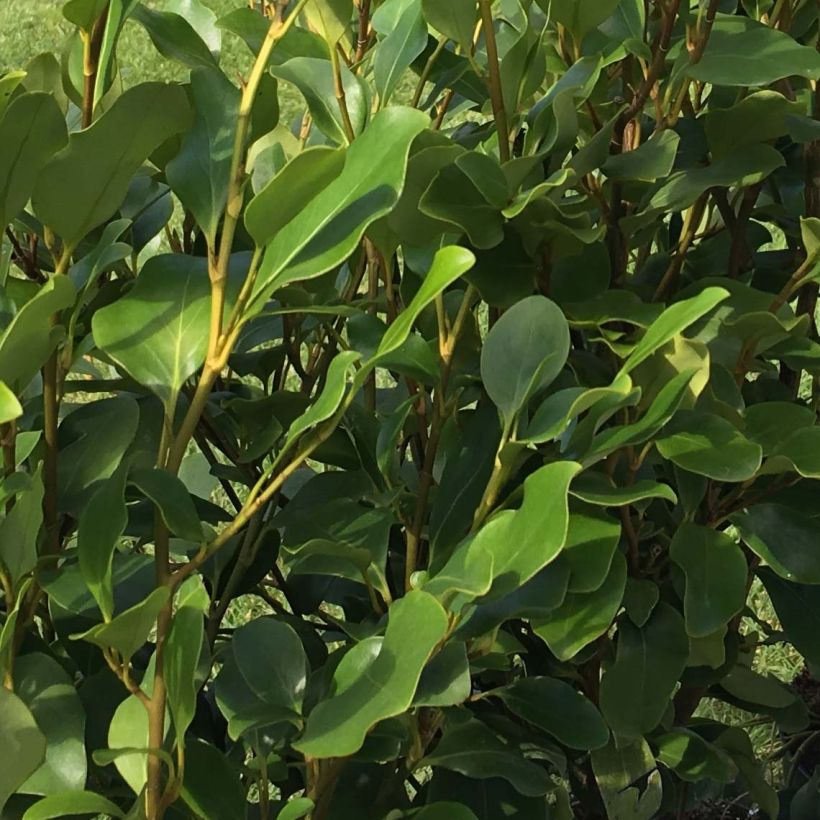

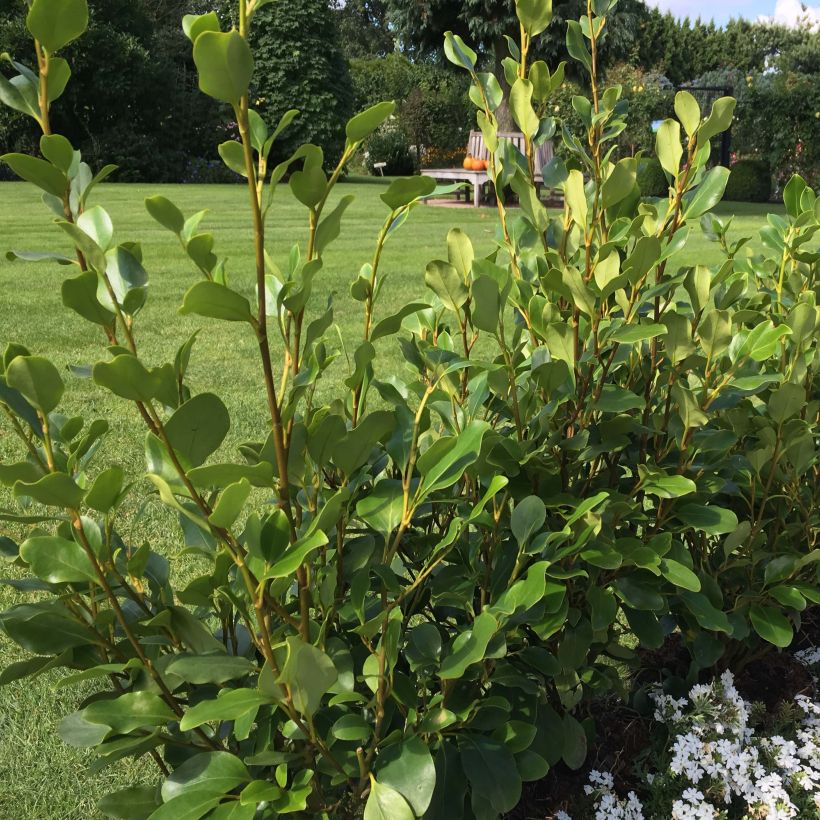

Plant habit
Flowering
Foliage
Botanical data
Griselinia
littoralis
Redge
Griseliniaceae (Cornaceae)
New Zealand Broadleaf, Kapuka, New Zealand Laurel, New Zealand Privet
Oceania
Other Griselinia
Planting and care
The Griselinia littoralis is best planted in spring, after the last frost in cool climates, or in September-October in warmer and drier climates in summer. Its hardiness does not exceed -7/-10 °C in perfectly drained soil and sheltered from dry and cold winds. Its foliage becomes deciduous in very cold winters or during extended periods of frost. Therefore, it is not recommended to use it in regions with harsh and humid winters. It adapts to any ordinary soil that is properly loosened and well-drained, but prefers a light, sandy, humus-rich, deep soil with minimal limestone, which remains moist to support its growth. This bush dislikes heavy and waterlogged soils in winter, and it is quite resistant to drought once well established. Choose a sunny, but not scorching, exposure, or partially shaded, especially in hot climates. This bush will bloom more in the sun.
It can tolerate light pruning: it should be done as needed 1 to 2 times a year, after flowering, in early or late summer. Shorten the branches that disrupt the harmony of the shape. The cuts must be clean and made with a well-sharpened and clean tool.
Insects and diseases:
The Griselinia is not prone to pest attacks. However, certain fungal diseases can affect it in humid soil and climate: spots may appear on the leaves.
Planting period
Intended location
Care
This item has not been reviewed yet - be the first to leave a review about it.
Evergreen shrubs
Haven't found what you were looking for?
Hardiness is the lowest winter temperature a plant can endure without suffering serious damage or even dying. However, hardiness is affected by location (a sheltered area, such as a patio), protection (winter cover) and soil type (hardiness is improved by well-drained soil).

Photo Sharing Terms & Conditions
In order to encourage gardeners to interact and share their experiences, Promesse de fleurs offers various media enabling content to be uploaded onto its Site - in particular via the ‘Photo sharing’ module.
The User agrees to refrain from:
- Posting any content that is illegal, prejudicial, insulting, racist, inciteful to hatred, revisionist, contrary to public decency, that infringes on privacy or on the privacy rights of third parties, in particular the publicity rights of persons and goods, intellectual property rights, or the right to privacy.
- Submitting content on behalf of a third party;
- Impersonate the identity of a third party and/or publish any personal information about a third party;
In general, the User undertakes to refrain from any unethical behaviour.
All Content (in particular text, comments, files, images, photos, videos, creative works, etc.), which may be subject to property or intellectual property rights, image or other private rights, shall remain the property of the User, subject to the limited rights granted by the terms of the licence granted by Promesse de fleurs as stated below. Users are at liberty to publish or not to publish such Content on the Site, notably via the ‘Photo Sharing’ facility, and accept that this Content shall be made public and freely accessible, notably on the Internet.
Users further acknowledge, undertake to have ,and guarantee that they hold all necessary rights and permissions to publish such material on the Site, in particular with regard to the legislation in force pertaining to any privacy, property, intellectual property, image, or contractual rights, or rights of any other nature. By publishing such Content on the Site, Users acknowledge accepting full liability as publishers of the Content within the meaning of the law, and grant Promesse de fleurs, free of charge, an inclusive, worldwide licence for the said Content for the entire duration of its publication, including all reproduction, representation, up/downloading, displaying, performing, transmission, and storage rights.
Users also grant permission for their name to be linked to the Content and accept that this link may not always be made available.
By engaging in posting material, Users consent to their Content becoming automatically accessible on the Internet, in particular on other sites and/or blogs and/or web pages of the Promesse de fleurs site, including in particular social pages and the Promesse de fleurs catalogue.
Users may secure the removal of entrusted content free of charge by issuing a simple request via our contact form.
The flowering period indicated on our website applies to countries and regions located in USDA zone 8 (France, the United Kingdom, Ireland, the Netherlands, etc.)
It will vary according to where you live:
- In zones 9 to 10 (Italy, Spain, Greece, etc.), flowering will occur about 2 to 4 weeks earlier.
- In zones 6 to 7 (Germany, Poland, Slovenia, and lower mountainous regions), flowering will be delayed by 2 to 3 weeks.
- In zone 5 (Central Europe, Scandinavia), blooming will be delayed by 3 to 5 weeks.
In temperate climates, pruning of spring-flowering shrubs (forsythia, spireas, etc.) should be done just after flowering.
Pruning of summer-flowering shrubs (Indian Lilac, Perovskia, etc.) can be done in winter or spring.
In cold regions as well as with frost-sensitive plants, avoid pruning too early when severe frosts may still occur.
The planting period indicated on our website applies to countries and regions located in USDA zone 8 (France, United Kingdom, Ireland, Netherlands).
It will vary according to where you live:
- In Mediterranean zones (Marseille, Madrid, Milan, etc.), autumn and winter are the best planting periods.
- In continental zones (Strasbourg, Munich, Vienna, etc.), delay planting by 2 to 3 weeks in spring and bring it forward by 2 to 4 weeks in autumn.
- In mountainous regions (the Alps, Pyrenees, Carpathians, etc.), it is best to plant in late spring (May-June) or late summer (August-September).
The harvesting period indicated on our website applies to countries and regions in USDA zone 8 (France, England, Ireland, the Netherlands).
In colder areas (Scandinavia, Poland, Austria...) fruit and vegetable harvests are likely to be delayed by 3-4 weeks.
In warmer areas (Italy, Spain, Greece, etc.), harvesting will probably take place earlier, depending on weather conditions.
The sowing periods indicated on our website apply to countries and regions within USDA Zone 8 (France, UK, Ireland, Netherlands).
In colder areas (Scandinavia, Poland, Austria...), delay any outdoor sowing by 3-4 weeks, or sow under glass.
In warmer climes (Italy, Spain, Greece, etc.), bring outdoor sowing forward by a few weeks.

































